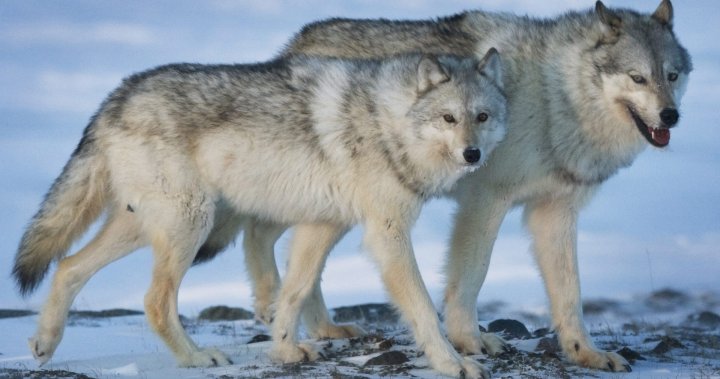The eastern wolf, a captivating and often misunderstood creature, stands on the precipice of enhanced protection, sparking hope among conservationists for a shift in public perception. Gisèle Benoit, an artist and documentary filmmaker, vividly recalls her first encounter with these elusive animals in 1984, a mesmerizing experience that etched itself into her memory. The sight of a family of eastern wolves emerging from the forests of Mauricie National Park, bathed in the ethereal glow of a rising moon, remains a cherished moment. This initial encounter sparked a lifelong fascination with these animals, leading Benoit to understand the significance of their precarious existence. The eastern wolf, distinct from the more common grey wolf, is now recognized as a separate species facing a critical threat to its survival.
Recent developments offer a glimmer of hope for the eastern wolf’s future. In July, the Canadian federal government elevated the eastern wolf’s threat level from “special concern” to “threatened,” a decision based on a 2015 report indicating a dwindling population, potentially as low as 236 mature individuals in their core habitat of central Ontario and southern Quebec. This reclassification mandates the development of a recovery strategy involving collaboration between federal and provincial governments, Indigenous communities, and other stakeholders. The strategy aims to protect the species on federal lands and guide comprehensive recovery efforts. This upgrade represents a significant step forward in acknowledging the urgent need for conservation measures to safeguard this unique canid.
However, the path to protection is fraught with complexities, particularly in Quebec. The province does not currently recognize the eastern wolf as a distinct species, instead classifying it as a “genetic group” resulting from interbreeding between grey wolves and coyotes. Despite this classification, Quebec authorities maintain that this does not preclude protection, as their laws also encompass subspecies and distinct wildlife populations. This nuanced stance highlights the challenges of aligning scientific understanding with policy decisions, especially when dealing with genetically complex species. Quebec has initiated a sample collection program to better understand the distribution and genetics of large canids, including the eastern wolf, a move that could ultimately inform more effective conservation strategies.
Despite the hurdles, there’s a growing sense of optimism amongst conservationists. Véronique Armstrong, co-founder of a Quebec wildlife protection association, notes a positive shift in government attitudes. While wolves were once heavily stigmatized and persecuted, there’s now a discernible movement toward greater protection. Armstrong’s organization has proposed a conservation area in southern Quebec, a proposal that has garnered preliminary support from several regional municipalities. This initiative underscores the growing recognition of the importance of protecting the eastern wolf’s habitat and ensuring its long-term survival.
The battle for the eastern wolf’s survival is not without precedent. In the 1990s and 2000s, John Theberge, a retired professor of ecology and conservation biology, and his wife spearheaded efforts to extend protection for eastern wolves beyond the boundaries of Algonquin Park. They faced significant resistance from hunting and trapping lobbies, but eventually succeeded in securing permanent hunting and trapping closures in areas adjacent to the park in 2004. This historical context demonstrates the power of advocacy and the potential for achieving meaningful conservation outcomes even in the face of opposition.
While challenges remain, especially concerning government-sanctioned wolf culls in provinces like Quebec, Alberta, and British Columbia to protect endangered caribou populations, public perception of wolves has evolved considerably. The fear and suspicion that once dominated have gradually given way to a greater appreciation for their ecological role and intrinsic value. The growing popularity of wolf-themed merchandise, a stark contrast to the past, symbolizes this shift in public opinion. The debate surrounding the eastern wolf’s taxonomic status, whether a distinct species, a subspecies of the grey wolf, or a coyote-wolf hybrid, continues. However, the federal government’s order protecting the eastern wolf affirms its distinct species status based on genetic analyses.
Beyond the scientific classifications, there’s a broader understanding of the eastern wolf’s critical importance to the ecosystem. As an umbrella species, protecting the eastern wolf indirectly benefits numerous other species within its habitat. Wolves play a crucial role in regulating prey populations, culling weak or sick individuals, and contributing to the overall health and balance of the ecosystem. Their complex social structures, with strong family bonds and cooperative behaviors, further underscore their significance. The eastern wolf’s intricate social dynamics, including older offspring assisting in raising younger pups, resonate with human observers and deepen the appreciation for their intelligence and social complexity. The growing recognition of the eastern wolf’s vital ecological role and its fascinating social behavior strengthens the case for its continued protection and underscores the interconnectedness of all species within the natural world.










